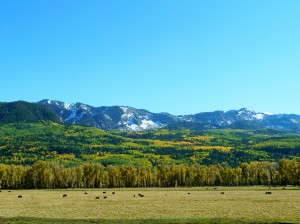Yes, it has. Since the downturn began in 2007, foreclosure properties have taken their toll on values throughout Southwest Colorado. Many homeowners found themselves in financial trouble, with mortgage loan balances far ahead of their adjusted market value. For some of these “underwater homeowners” there was little to do other than wait things out. For other less fortunate borrowers, their hands were forced when second mortgages became due, or when their adjustable rate first mortgage reset. A number of purchasers acquired their properties using one or more of the creative financing options the banks were offering at the time. In some cases the special mortgage product allowed purchasers to get into homes with no money out of pocket. In others, the initial interest rate was set artificially low, with an upward adjustment set 3-5 years out. Some of these initial rates were as low as 1.9%. Monthly payments were set at 60% or more below the level of normal market rate interest for fixed rate mortgages at the time. When these mortgage rates were reset, many of the borrowers were unable to keep up with the new payment schedules. The monthly payment amounts doubled and tripled for some borrowers. Attempts to refinance again into a fixed rate mortgage were unsuccessful as values had declined to the point that many borrowers no longer had any equity in their homes.
For some time it appeared as though the banks were genuinely trying to work with borrowers to keep as many people in their homes as possible. After a while, it became apparent that the heavily promoted federal programs were doing little if anything to stem the tide of foreclosures. Only a handful of borrowers were assisted by the programs that were so heavily publicized and very few of those resided here in Pagosa Springs or Durango, Colorado.
Fast forward to today. Mortgage interest rates are at historic lows. Qualified borrowers can obtain 30 year fixed rate mortgages below 3.5%. In some regions of the county, values have increased by 15%-25% above the floor established during the downturn. Within certain price ranges homes have gone up as much as 40% in the Phoenix market. Lenders there are cautious about playing into a re-inflation of the market. Values here in Southwest Colorado have not experienced the increases of Phoenix, but, thankfully we are finally seeing a diminishing influence of the foreclosure and distress sales. The pipeline of new foreclosures has declined and we expect the negative impacts to lessen significantly during the next 12-24 months. Some borrowers that were foreclosed or forced into short sales in 2006-2008 are already re-qualifying for home loans. Where they have repaired their credit and saved up a down payment, lenders have shown a willingness to get them back into home ownership. Rental rates have shifted now making ownership more economical in many regions.
The health of the second home or vacation residence market really depends largely on the level of consumer confidence that exists within the geographic markets buyers are drawn from. Historically, Durango and Pagosa Springs, Colorado have attracted buyers from Arizona, California, New Mexico and Texas. Presently consumer confidence is strongest within the state of Texas. Its residents did not experience the drastic meltdown in residential real estate values that were seen in Arizona and other states. Also, the price of energy has remained relatively strong throughout the recession and that has kept employment figures within Texas fairly strong while other states experienced significant job losses. We have experienced a resurgence of buying interest from residents of Texas during the downturn and I expect it will continue unless energy prices declined considerably. Some would say this is a mixed blessing. We are glad to have Texans buying second homes and other real estate in our area. Their value baseline tends to be less favorable than residents of other states such as California and Arizona where residential values are generally much higher. For our firm, we welcome buyers, from anywhere and we have helped folks from as far away as Australia and Switzerland to become involved in property ownership here. The Texas Buyers coming to Pagosa Springs and Durango can continue to support our market until consumer confidence among folks in Arizona, California and New Mexico improves enough to make them feel comfortable investing in a second home here in the mountains again.


